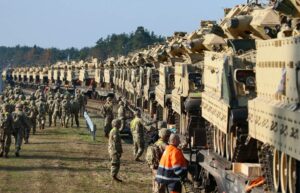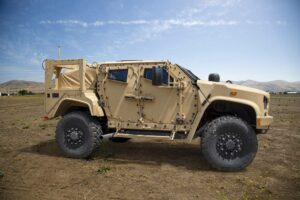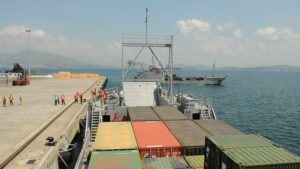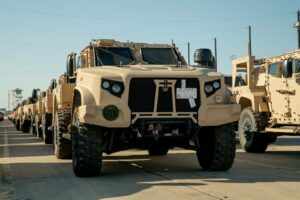WASHINGTON — The US Air Force’s next-generation nuclear missile will reach the fleet in mid-2030, months later than originally planned, as staffing shortfalls, supply chain issues and software challenges persist.
The LGM-35A Sentinel intercontinental ballistic missile — formerly known as the Ground Based Strategic Deterrent — will reach its initial operational capability sometime between April and June 2030, the Government Accountability Office said in a June 8 weapons assessment report.
RELATED

That schedule has slipped from the program’s previous estimates, which anticipated the missile would start replacing the Cold War-era LGM-30G Minuteman III ICBM sometime in 2029.
Officials with Northrop Grumman, the prime contractor on the program, did not immediately respond to requests for comment.
The $100 billion Sentinel program is one of the Defense Department’s top priorities, with the more than 50-year-old Minuteman III program approaching the end of its life and in need of replacement. The Air Force’s Minuteman III program now has 400 missiles and 450 silos spread across nearly 32,000 square miles.
The Air Force is now expected to make a decision on full-rate production of the Sentinel sometime between July and September 2030.
Supply chain struggles, including shortages of materials and long lead times for basic commodities, have hampered the Sentinel program and caused it to slip behind schedule, GAO said. Northrop is working on several steps to try to ease the supply chain crunch, it said.
Staffing shortfalls — particularly in finding skilled software workers — and delays in the processing of security clearances needed to work on the program have also slowed the program down, according to the report.
Technical problems have also hampered Sentinel. Classified information technology infrastructure issues have contributed to the schedule delays, GAO said. And the complexity and scope of Sentinel’s unique software development effort is also at a high risk.
Sentinel delivered its first incremental software capability, dubbed IFC 0.5, in August 2022. This software capability showed how the missile and its command and launch modules would connect in a simulated environment.
But follow-up software capabilities are lagging, GAO said, and IFC 1.0 is expected to be late and over cost.
The Air Force and National Security Agency also have not yet approved a way to transfer data between networks with different security classifications, which is also limiting the program.
The large scope of the Sentinel program, which encompasses hundreds of facilities and operations over thousands of miles and requires the creation of new technologies and infrastructure, is also adding to the program’s complexity, GAO said.
The program office told GAO that its main schedule “contains many deficiencies and cannot be used to effectively manage the execution of the program.” Northrop and the program are now reviewing the schedule and considering how to possibly change it, GAO said.
The Air Force’s arsenal of ICBMs makes up one element of the U.S. nuclear triad, with submarines and bomber aircraft armed with their own nuclear weapons comprising the rest. The Air Force is also in the process of upgrading its bomber fleet, with Northrop Grumman-made B-21 Raider stealth bombers now in production.
Stephen Losey is the air warfare reporter for Defense News. He previously covered leadership and personnel issues at Air Force Times, and the Pentagon, special operations and air warfare at Military.com. He has traveled to the Middle East to cover U.S. Air Force operations.
- SEO Powered Content & PR Distribution. Get Amplified Today.
- EVM Finance. Unified Interface for Decentralized Finance. Access Here.
- Quantum Media Group. IR/PR Amplified. Access Here.
- PlatoAiStream. Web3 Data Intelligence. Knowledge Amplified. Access Here.
- Source: https://www.defensenews.com/battlefield-tech/space/2023/06/14/next-gen-nuclear-missile-rollout-slips-on-supply-chain-software-woes/
- :has
- :is
- :not
- $UP
- 000
- 1
- 10
- 2022
- 2030
- 32
- 70
- 8
- a
- According
- accountability
- across
- adding
- agency
- AIR
- Air Force
- aircraft
- also
- and
- and infrastructure
- Anticipated
- approaching
- approved
- April
- ARE
- armed
- Arsenal
- AS
- assessment
- At
- AUGUST
- based
- basic
- BE
- behind
- between
- Billion
- cannot
- capabilities
- caused
- chain
- challenges
- change
- classified
- cold
- COM
- comment
- Commodities
- complexity
- comprising
- Connect
- considering
- Contractor
- contributed
- Cost
- cover
- covered
- creation
- crunch
- D.C.
- data
- decision
- Defense
- delays
- delivered
- Development
- DID
- different
- down
- dubbed
- ease
- East
- effectively
- effort
- element
- encompasses
- end
- Environment
- estimates
- Ether (ETH)
- execution
- expected
- facilities
- false
- finding
- First
- FLEET
- For
- Force
- formerly
- from
- GAO
- Have
- he
- High
- How
- How To
- http
- HTTPS
- Hundreds
- iii
- image
- images
- immediately
- in
- Including
- information
- information technology
- Infrastructure
- initial
- issues
- IT
- ITS
- jpg
- July
- june
- known
- lagging
- large
- Late
- later
- launch
- lead
- Leadership
- Life
- Long
- Main
- make
- MAKES
- manage
- many
- materials
- Middle
- Middle East
- Military
- missiles
- Modules
- months
- more
- National
- national security
- National Security Agency
- nearly
- Need
- needed
- networks
- New
- New technologies
- news
- now
- nuclear
- Nuclear weapons
- of
- Office
- on
- ONE
- operational
- Operations
- originally
- over
- own
- particularly
- pentagon
- Personnel
- planned
- plato
- Plato Data Intelligence
- PlatoData
- possibly
- previous
- previously
- Prime
- problems
- process
- processing
- Production
- Program
- reach
- replacement
- report
- reporter
- requests
- requires
- Respond
- REST
- reviewing
- Risk
- rollout
- s
- Said
- schedule
- scope
- Screen
- security
- seen
- September
- several
- shortages
- showed
- silos
- skilled
- Software
- software development
- special
- spread
- square
- staffing
- start
- Stealth
- Steps
- Strategic
- Struggles
- supply
- supply chain
- Technologies
- Technology
- technology infrastructure
- than
- that
- The
- their
- this
- thousands
- times
- to
- top
- transfer
- traveled
- try
- u.s.
- U.S. Air Force
- unique
- us
- used
- washington
- Way..
- Weapons
- which
- will
- with
- Work
- workers
- working
- would
- yet
- zephyrnet












